Patient and Family Engagement
Facilitator Notes
Contents
Slide 1. Cover Slide.
Slide 2. Learning Objectives
Slide 3. The Patient's Hospital Experience1
Slide 4. Patient- and Family-Centered Care3
Slide 5. What is Patient Family Engagement1
Slide 6. Who are Advisors and What do they do?
Slide 7. Characteristics of an Engaged Advisor1
Slide 8. Characteristics of an Engaged Advisor
Slide 9. How To Work With Patient and Family Advisors1
Slide 10. How To Engage Patients and Families1
Slide 11. How To Engage Patients and Families (continued)1
Slide 12. Effective Patient and Family Communication
Slide 13. The Importance of Effective Communication
Slide 14. The Link Between Communication and Patient Safety1
Slide 15. Communication Tips1
Slide 16. IDEAL Discharge Planning
Slide 17. What Is IDEAL Discharge Planning?1
Slide 18. Benefits of IDEAL Discharge Planning for Clinicians1
Slide 19. IDEAL Discharge
Slide 20. What if an Adverse Event Occurs on the Unit?
Slide 21. Engagement Strategies
Slide 22. Introduction to Adverse Events
Slide 23. Immediate Response to an Adverse Event4
Slide 24. Next Steps in Responding to an Adverse Event5
Slide 25. How to Communicate About an Adverse Event6
Slide 26. The Second Victim: Health Care Workers7
Slide 27. Summary
Slide 28. Tools
Slide 29. References
Slide 30. References
Slide 1. Cover Slide

Say:
The Patient and Family Engagement module of the Comprehensive Unit-based Safety Program (or CUSP) Toolkit focuses on an important topic: Making sure patients and their family members understand what is happening during the patient’s hospital stay, are active participants in the patient’s care, and are prepared for discharge.
[D] Select for Text Description.
Slide 2. Learning Objectives

Say:
In this module we will:
- Explore the role of patient and family advisors in ensuring patients' and families' views are incorporated into hospital policies and procedures.
- Describe how to work with patient and family advisors as part of the CUSP team.
- Present tools to improve communication among patients, families, and clinicians; and
- Discuss how to communicate an adverse event to patients and family members.
[D] Select for Text Description.
Slide 3. The Patient's Hospital Experience1

Say:
According to the Institute for Patient- and Family-Centered Care, patient-and-family centered care involves “collaborating with patients and families of all ages, at all levels of care, and in all health care settings. [Patient and family engagement] acknowledges that families, however they are defined, are essential to patients’ health and well-being.”
Core concepts of patient and family engagement include dignity and respect, information sharing, participation, and collaboration.
Dignity and respect
Health care practitioners listen to and honor patient and family perspectives and choices. Patient and family make-up, knowledge, values, beliefs, and religious and cultural backgrounds are incorporated into care planning and delivery.
Information sharing
Health care practitioners share complete and unbiased information with patients and families in ways that are easily understood and address concerns or questions. Patients and families receive timely, complete, and accurate information to participate in care and decisionmaking.
Participation
Patients and families are encouraged to participate in care and decisionmaking at the level they choose.
Collaboration
Patients, families, health care practitioners, and health care leaders collaborate in policy and program development, execution, and evaluation, as well as in facility design, professional education, and care delivery.
[D] Select for Text Description.
Slide 4. Patient- and Family-Centered Care3

Say:
The goal of patient and family engagement is to create a set of conditions where patients, family members, clinicians, and hospital staff are all working together as partners to improve the quality and safety of care. This partnership is important because health care quality and safety directly affect patients and families. It makes sense that we should ask patients and family members to take part in changes and improvements.
On one level, patient and family engagement means providing day-to-day care experiences that welcome and engage patients and families as members of the health care team. For example, care team members can provide opportunities for patients and family members to be involved in their care by:
- Making sure that patients and family members are invited to partner with their health care team throughout their stay
- Conducting change-of-shift report at the bedside so patients and families can participate
- Involving patients and families in discharge planning and plans for safe care at home
- [Insert other examples of how your hospital provides opportunities for true partnership and engagement during the hospital stay]
On another level, patient and family engagement means that patients and family members are involved beyond their own care as organizational partners, or advisors, for example, working with staff, clinicians, and leaders to improve policies, processes, programs, facility design, and education for hospital staff, clinicians, and trainees in the health professions.
Patient and family engagement is not:
- Getting patients and families to do what caregivers want them to. It is a shared partnership where patients and care team members listen to each other and decide on the best plan of action.
- Getting patients and families to like clinicians. It is about improving quality and safety by communicating and partnering more effectively.
- Handing patients and families a brochure. A piece of paper alone will not engage patients and families.
- Abandoning critical judgment. Clinicians work with the patient and family to help them choose what is right for them. Clinicians bring clinical judgment to the table, and while this is important, it is not the only perspective.
In addition to serving as part of the CUSP team to provide their perspective, patients and their family members can also be advisors to the hospital staff to improve policies and procedures.
Slide 5. What is Patient Family Engagement?1

Say:
Being aware of what patients face when they are in the hospital can help clinicians and hospital staff better understand a patient’s perspective.
- Hospitals can present a very unfamiliar setting, system, and culture for patients.
- Patients may not understand the roles of different staff on their care team.
- Patients are often in pain and may feel vulnerable in the hospital.
Patients may be hesitant to make requests of busy staff.
[D] Select for Text Description.
Slide 6. Who are Advisors and What do they do?

Say:
A patient and family advisor is a former patient or family member of a patient who is a collaborative partner at all stages in developing hospital policies, procedures, and practices.
Hospitals may use a formal process when they are ready to invite patient and family advisors to participate on hospital committees. For example, the hospital may recruit patient and family advisors through an application and interview process.
Patients and their family members are ready to become advisors when:
- They are willing to talk about their experiences constructively,
- They are ready to work with people from different backgrounds who have different viewpoints, and
- They are willing to be discreet about the information they receive.
Including patient and family advisors from different cultures and those who do not speak English can capture the perspective from this patient demographic. If the hospital chooses a non-English-speaking advisor, it should supply a medical interpreter for all meetings the advisor attends.
For more information on an advisor’s role and responsibilities, patients and family members who are interested in becoming advisors can refer to the Am I Ready to Become an Advisor? tool, which is listed as one of several tools at the end of this module.
Once a committee chooses a patient and family advisor, the committee leaders should work to create a safe, considerate environment for the patient and family advisor to share his or her experiences and opinions. It is helpful to prepare health care professionals to work with advisors by explaining the advisor’s role, contributions, and expectations for involvement. The committee leader may also need to help the patient and family advisor learn ways to express the concerns of patients and families while being respectful of the health care staff.
Advisors collaborate with hospital staff to develop patient- and family-centered policies and procedures. Hospital staff members rely on the opinions of patient and family advisors and consult them when deciding matters concerning patient experiences, care delivery, educational materials, and facility design.
For more information on how to partner with advisors, hospitals can refer to the Working With Advisors handout, which is listed as one of several tools at the end of this module.
[D] Select for Text Description.
Slide 7. Characteristics of an Engaged Advisor1

Say:
When selecting advisors, think about what other advisors have said are important characteristics of effective advisors. Engaged advisors are respectful of others when sharing their experiences, listen well, share their views, communicate effectively, ask questions, and are prepared for disagreements
Listen well
Effective patient and family advisors are good listeners. They listen to the questions hospital staff ask and provide respectful, honest feedback. Advisors work with physicians, nurses, administrators, and support staff to ensure their contributions are received. Staff may use active listening and repeating back to validate that the information the advisor is trying to convey is understood.
Share views
Effective patient and family advisors are good listeners. They listen to the questions hospital staff ask and provide respectful, honest feedback. Advisors work with physicians, nurses, administrators, and support staff to ensure their contributions are received. Staff may use active listening and repeating back to validate that the information the advisor is trying to convey is understood.
Communicate effectively
Effective communication ensures the best outcomes from meetings with the hospital staff and the patient and family advisor. Ensuring everyone understands the ideas being discussed will contribute to successful meetings.
Ask questions
Patient and family advisors need to feel comfortable asking nurses, physicians, and administrators questions, and the care team should feel comfortable asking the advisor questions.
Expect disagreements
Patient and family advisors, as well as hospital staff, should be prepared to resolve disagreements tactfully and not take others' opinions personally..
[D] Select for Text Description.
Slide 8. Characteristics of an Engaged Advisor

Do:
Play the video.
Ask:
- How did Theresa approach the CUSP team?
- What insight did Theresa provide on the patient’s experience?
- Does Theresa make a good patient and family advisor? Why or why not?
[D] Select for Text Description.
Slide 9. How to Work With Patient and Family Advisors1
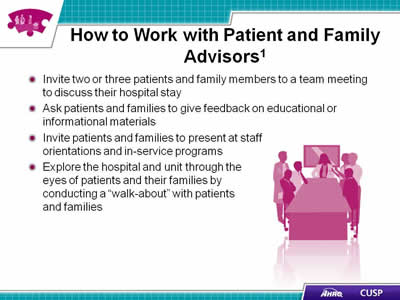
Say:
CUSP teams can involve patient and family advisors in their work by:
- Inviting advisors to a CUSP meeting to participate as active guests on the team and asking them to share their thoughts during the meeting.
- Asking advisors to develop and comment on educational or informational materials.
- Inviting advisors to talk at staff orientations and in-service programs about the care the patient and family received on the unit.
- Exploring the hospital and unit through the eyes of patients and their families by doing a “walk-about” with advisors.
These informal thought-sharing activities will help hospital staff gain a better understanding of the needs and attitudes of patients and their families during hospital stays.
Patient and family advisors offer insights that are different from the hospital staff's. They help the CUSP team develop new priorities and innovative ideas that contribute to delivering high-quality, patient-centered care.
[D] Select for Text Description.
Slide 10. How To Engage Patients and Families1

Say:
Patient and family advisors can provide valuable insight on the best ways to communicate with and engage patients and families during the hospital stay. How hospital staff members communicate with patients and families can affect patient engagement. Simple actions, such as entering a room and assessing a patient, can affect the patient’s attitude about his or her care.
Entering a room
Hospital staff should read the patient's chart before stepping into the room. Once they enter a room, they should:
- Make eye contact with the patient,
- Introduce themselves by name and role, and
- Introduce new people in the room by name and role and explain what they will do.
Assessing a patient
When staff first assess the patient, they should:
- Ask how the patient prefers to be addressed,
- Identify family members who are involved in the patient's care, and
- Invite the patient and family members to write questions on the white board to communicate with the clinicians.
[D] Select for Text Description.
Slide 11. How To Engage Patients and Families1 (continued)

Say:
Staff should ask about and listen to the patient and family's needs and concerns. They should:
- Use open-ended questions, not questions that can be answered with a “yes” or “no”;
- Try to see the experience through the patient's eyes;
- Listen to, respect, and act on what the patient and family say;
- Help the patient and family articulate their concerns; and
- Enlist the help of a translator for the patient or family member when necessary.
Educating the patient and family
Staff should help the patient and family understand the diagnosis, condition, and next steps. They should:
- Give timely and complete information,
- Use plain language, and
- Invite the patient or a family member to take notes.
[D] Select for Text Description.
Slide 12. Effective Patient and Family Communication

Do:
Play the video.
Ask:
- How did the nurse address the patient's and family member's questions and concerns?
- What else could the nurse have done to ensure effective communication with the patient and family member?
[D] Select for Text Description.
Slide 13. The Importance of Effective Communication

Say:
Communication among CUSP team members and patient and family members is important to the delivery of high-quality, patient-centered care.
[D] Select for Text Description.
Slide 14. The Link Between Communication and Patient Safety1

Say:
Effective communication and collaboration with patients and family members affects patient outcomes, patient safety, and perceptions of quality. If patients feel involved in their care, they will be more likely to follow their treatment plans and may experience better clinical outcomes.
[D] Select for Text Description.
Slide 15. Communication Tips1

Say:
When communicating with patients and their families, unit team members should follow the tips below to ensure their messages are communicated clearly.
Speaking slowly
Speaking slowly and clearly helps listeners understand the message without having to ask the speaker to repeat content
Use plain language
Not using jargon and acronyms helps prevent miscommunication and makes patients and family members more comfortable collaborating with staff.
Provide information
Sharing information with patients and their families alleviates stress and makes sure everyone is on the same page and has an opportunity to discuss the patient's care.
Thank the patient and family for raising concerns
Patients and their families must feel comfortable with calling attention to issues that arise. When hospital staff members take concerns seriously, the patient and family likely will be more inclined to carry out all aspects of the patient's care.
Invite questions
Patients and their family members need to feel comfortable asking questions. Staff members should ask patients and their families what questions they have to ensure an open line of communication exists.
[D] Select for Text Description.
Slide 16. IDEAL Discharge Planning
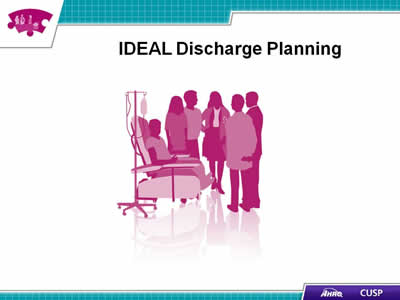
The following section discusses the IDEAL Discharge Planning tool and how to use it in discharge planning. You can find more information on the tool in AHRQ’s Guide to Patient and Family Engagement in Hospital Quality and Safety at http://www.ahrq.gov/professionals/systems/hospital/engagingfamilies/index.html .
[D] Select for Text Description.
Slide 17. What Is IDEAL Discharge Planning?1
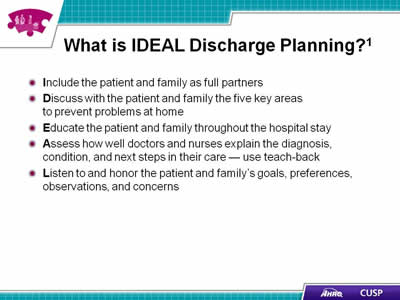
Say:
IDEAL discharge planning calls for the CUSP team to begin engaging patients and families in the discharge process as soon as the patient is admitted. Discharge from the hospital to home requires successful transfer of information between clinicians and the patient and family to reduce the risk of adverse events and to prevent readmissions. IDEAL is a mnemonic device:
- I equals Include the patient and family as full partners.
- D equals Discuss with the patient and family the five key areas to prevent problems at home. These are:
- Describe what life at home will be like. Include the home environment, support needed, what the patient can or cannot eat, and activities to do or avoid.
- Review medications. Use a reconciled medication list to discuss the purpose of each medicine, what to take, how to take it, and potential side effects.
- Highlight warning signs and problems. Write down the name and contact information of someone to call if there is a problem.
- Explain test results to the patient and family. If test results are not available at discharge, let the patient and family know when they should hear about results and identify whom they should call if they have not heard the results by that date.
- Make followup appointments. Offer to make followup appointments for the patient. Make sure that the patient and family know what followup is needed.
- E equals Educate the patient and family throughout the hospital stay.
- A equals Assess how well doctors and nurses explain the diagnosis, condition, and next steps in care using the Teach-Back Tool.
- L equals Listen to and honor the patient's and family's goals, preferences, observations, and concerns.
[D] Select for Text Description.
Slide 18. Benefits of IDEAL Discharge Planning for Clinicians1
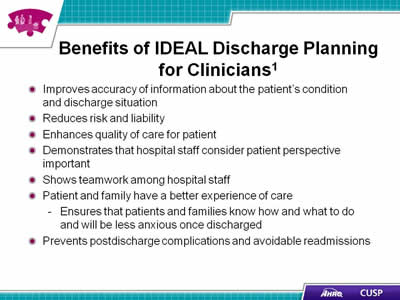
Say:
Using the IDEAL discharge planning process helps ensure that clinicians, patients, and family members share a common understanding of issues and expectations related to discharge.
The IDEAL planning process:
- Improves the accuracy of information on the patient's condition and discharge situation.
- Reduces risk and liability.
- Demonstrates that hospital staff members consider patient perspective important.
- Shows teamwork among hospital staff.
- Improves patient and family care experiences.
- Reassures patients and families that they know what to do and how to do it, and
- Prevents postdischarge complications and avoidable readmissions.
[D] Select for Text Description.
Slide 19. IDEAL Discharge
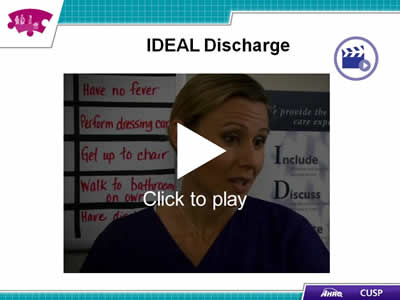
Do:
Play the video.
Ask:
- What components of the IDEAL discharge planning process were captured in this video?
- What else could the health care team have done to ensure the patient and family member were involved?
[D] Select for Text Description.
Slide 20. What if an Adverse Event Occurs on the Unit?
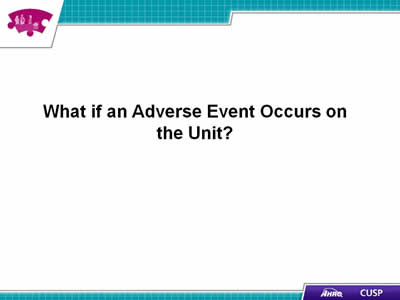
Say:
Hospitals must also have strategies in place to engage patients and families if an adverse event occurs.
[D] Select for Text Description.
Slide 21. Engagement Strategies
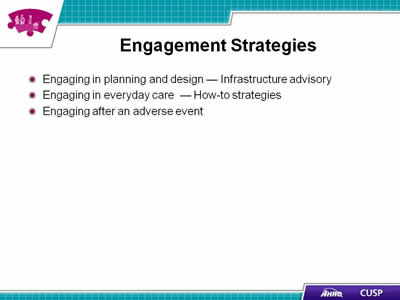
Say:
There are three engagement strategies that a CUSP team should consider:
- Planning and design
- Everyday care
- After an adverse event
[D] Select for Text Description.
Slide 22. Introduction to Adverse Events
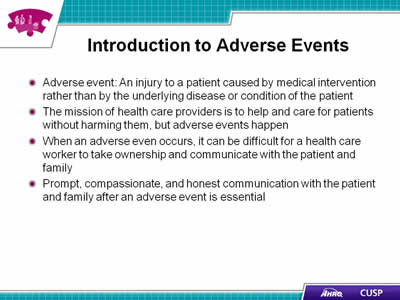
Say:
Adverse events occur when a patient is harmed as a result of receiving medical care. Medical providers are committed to caring for their patients; however, adverse events can happen. When they do, staff need know how to communicate with the patient and family.
Prompt, compassionate, honest, and accurate communication with the patient and family after an adverse event happens ensures they receive information they can use to chart their next steps.
[D] Select for Text Description.
Slide 23. Immediate Response to an Adverse Event4
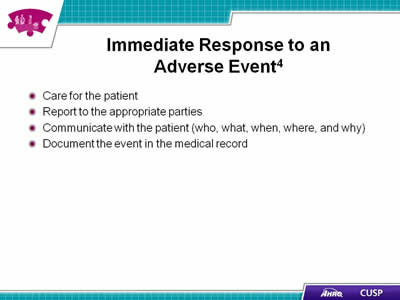
Say:
Each hospital has policies and procedures for actions to take after an adverse event occurs, and most involve working with a risk management professional. Immediately after an adverse event, care providers :
- Provide care. Caring for the patient's physical needs after an event is the first step a provider must take.
- Report. Providers report the incident to the unit manager and the risk management department following the hospital's policies and procedures.
- Communicate. Providers communicate the facts of what happened and assure the patient and family that they will receive new information as it is discovered.
- During the initial communication with the patient and family, providers should:
- Communicate only relevant facts that are reasonably certain at the time because further investigation and resolution may be necessary.
- Advise the patient and family that communication will be ongoing as follow-up investigation occurs.
- Advise the patient and family of a designated contact person for their questions and concerns.
- During the initial communication with the patient and family, providers should:
- Document. Providers must document in the medical record the facts of the incident and any intervention the patient received as a result of the incident. The discussion with the patient should also be documented. The documentation should include an objective description of the event, the patient's response to the event, and the care provided as a result of the event.
[D] Select for Text Description.
Slide 24. Next Steps in Responding to an Adverse Event5
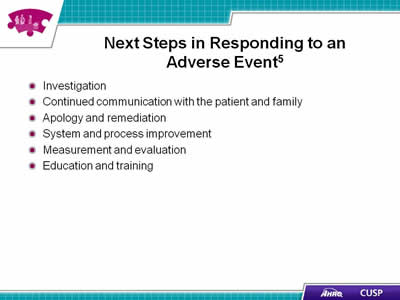
Say:
When an incident occurs, the hospital will investigate and analyze it (e.g., a root cause analysis may be conducted) to determine if patient harm occurred. When the hospital determines that unreasonable care was provided, the following information should be communicated to the patient and family:
- An apology for any unreasonable care
- An explanation of what happened
- A meaningful discussion of projected outcomes
- An early offer of remediation (such as waiving hospital bills) and compensation.
The hospital should use information learned from the investigation to identify and implement system and process improvement. It should track, trend, and analyze necessary data for quality assurance and other identified purposes. The hospital should also establish initial and continual training requirements for professional, administrative, and support staff.
[D] Select for Text Description.
Slide 25. How to Communicate About an Adverse Event6
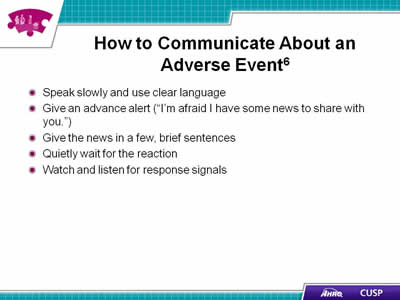
Say:
Patients and family members experience a number of emotions when an adverse event occurs. The care provider should speak slowly and use clear language. The provider should begin with an alert, such as, “I’m afraid I have some news I need to share with you” and then provide the information in a few short sentences. The provider should wait for a response. A hospital committed to transparency offers an apology that the incident happened.
[D] Select for Text Description.
Slide 26. The Second Victim: Health Care Workers7
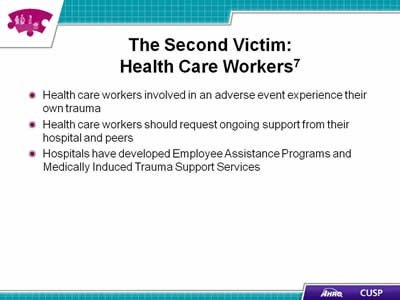
Say:
Adverse events are often system failures. Rarely does an adverse event occur as a result of intent. Health care workers hold themselves to very high standards, and when an incident happens, they should request support from the hospital and their peers to regain their confidence. Hospitals today recognize that health care workers are the second victims of adverse events and often provide psychological support through Employee Assistance Programs and Medically Induced Trauma Support Services after an incident occurs.
[D] Select for Text Description.
Slide 27. Summary
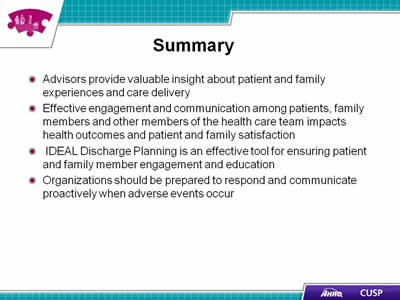
Say:
- Patient and family advisors provide valuable insight about patient and family experiences and care delivery.
- Effective engagement and communication among patients, family members, and other members of the health care team can benefit health outcomes and patient and family satisfaction.
- IDEAL discharge planning is an effective tool for ensuring patient and family member engagement and education.
- Organizations need to engage in strategies to address adverse events.
[D] Select for Text Description.
Slide 28. Tools
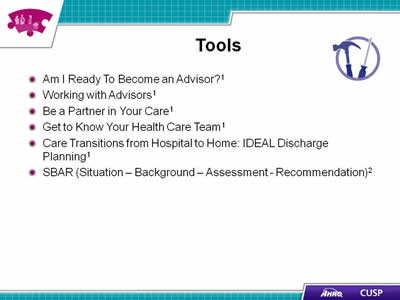
Say:
In addition to the information presented in this module, CUSP tools are available online by visiting the AHRQ Web site: http://www.ahrq.gov/professionals/education/curriculum-tools/cusptoolkit/index.html.. The tools in this module will help clarify the roles and responsibilities of advisors as part of the CUSP team and present communication strategies for patients and family members.
Am I Ready to Become an Advisor?
This tool provides a series of statements to help someone determine whether or not they are ready to become an advisor. Sample statements include:
- I am willing to talk about the positive and negative care experiences I had as a patient or family member of a patient.
- If I had any negative experiences, I am coping well and am ready to respectfully share my ideas about how things could have gone differently.
Working With Advisors
This handout discusses the importance of working with patient and family advisors and ways in which an organization can engage patient and family advisors.
Be a Partner in Your Care
This handout gives information about routine events and highlights tools the hospital uses to talk with a patient and his or her family (e.g., white boards). It summarizes the main action items from the other handouts for the patient, family, and clinicians.
Get to Know Your Health Care Team
This tool provides patients and family members with an overview of the roles and responsibilities of their health care team.
Care Transitions from Hospital to Home: IDEAL Discharge Planning
This form explains the components of a discharge plan and provides guidance for involving the patient and family members in the discharge discussion.
SBAR
SBAR is an easy-to-remember, concrete mechanism that is useful for framing any conversation, especially a critical discussion requiring a clinician's immediate attention and action. In phrasing a conversation with another member of the team, consider the following:
- Situation—What is happening with the patient?
- Background—What is the clinical background?
- Assessment—What do I think the problem is?
- Recommendation—What would I recommend?
[D] Select for Text Description.
Slide 29. References
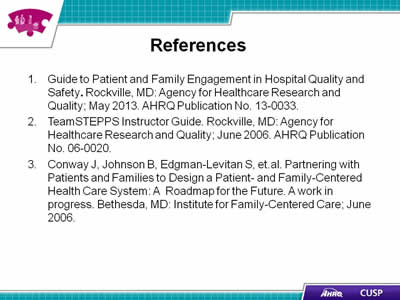
[D] Select for Text Description.
Slide 30. References
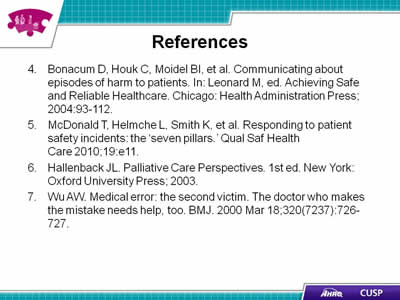
[D] Select for Text Description.



